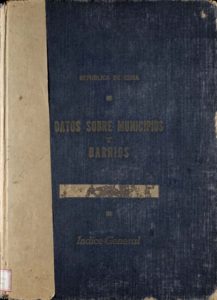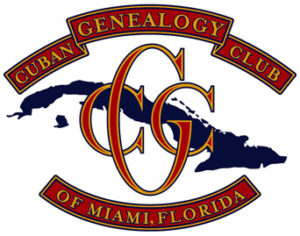Digitized/Digital Books
National/All Provinces
About Digitized Books - National/All Provinces
Our current collection of digitized or digital books or essays on Cuba.
Many of our Digitized Books are free to view and download. The content that requires a Membership are labeled as “PREMIUM.”
These items are available on the Books Page for Members in our Members Only Area. A membership login is required to access those files.
Historias de Familias Cubanas

This 9-volume collection by Conde de San Juan de Jaruco y Santa Cruz de Mopox represents the most extensive collection ever compiled of Cuban genealogies. It has 841 surname entries.
Ed Elizondo, webmaster for CubaGenWeb, has graciously allowed us to link to his site. He has the digitized files (or links) to volumes 1, and 6 of the collection.
Digital files for Volumes 2 through 6 also available through Internet Archive.
Diccionario Heráldico y Genealógico de Apellidos Españoles y Americanos
by the brothers Alberto & Arturo Garcia Carraffa
Alternate Name: Enciclopedia heráldica y genealógica; diccionario de apellidos.
Written and compiled from 1920 to 1968; the work stopped with the URRIZA surname when the last of the brothers died. The writer Endika de Mogrobejo has completed the work by finishing the list of surnames. [Volumes 87 to 101 (Urriza a Zuzuarregui) were published under the title “Diccionario hispanoamericano de heráldica, onomástica y genealogía.”]
Digital images of all 76 volumes available on FamilySearch
*Scroll down the page to the “Film/Digital Notes” section and click on the camera icon*
PDFs from available from the webpage Historia y Genealogia Hispanoamericano
Volumes are also available through the Internet Archive.
Ferrocarril, Historia, Espacio y Patrimonio en Cuba
Digital book published in 2020 at DIGITAL.CSIC.
Available for download on their website.
National - Locations in Cuba

Cuba Descriptiva:
Datos sobre Municipios y Barrios
by
Carlos Garcia Velez y Augusto Casamayor Guerrero, Compilers
This collection is a kind of gazetteer for Cuba. This series of books list the names of cities, towns, neighborhoods, rivers, etc. throughout the island of Cuba. These facts were compiled between 1911 – 1913. They describe the towns/cities/hamlets/homesteads and surrounding areas of the 6 original provinces. They also list churches, sugar mills (ingenios), agricultural farms (haciendas), lands used for the production of tobacco (vegas) as well as sites for farming and grazing horses and livestock (potrero.) Some give a history of the area as well as when it was founded. They name the mayor and other officials. It is a unique snapshot of the island of Cuba at the time.
PLEASE NOTE: These books are available for download from Internet Archive (archive.org.)
Clicking on a title will take you to that volume on the Internet Archive site.
National
The History of Cuba
by
Willis Fletcher Johnson
National
Datos y noticias oficiales referentes a los bienes mandados embargar en la isla de Cuba por disposición del Gobierno superior político.
Published in 1870
(Habana: Imp. del Gobierno y Capitania General)
Book (218 pages)
Available through Biblioteca Digital Hispánica (Biblioteca Nacional de España)
An incredible number of names are listed in this book!
Book is searchable – click on the binocular icon in the upper left menu
- Listing of “fincas urbanas” and their owners start on pg. 25 of the ebook (pg. 17 of the actual book)
- Names of individuals start on pg. 117 of ebook (pg. 109 of the actual book)
National
Blue Guide to Cuba: 1949
by
Roger Le Febure, Editor
Cuban Tourist Guide
Donated by CGC Member, Linet Dominguez, from her personal collection.
National
Catálogo de Extranjeros Residentes en Puerto Rico en Siglo XIX
by
Estela Cifre de Loubriel
Source: La inmigración a Puerto Rico durante el Siglo XIX by Estela Cifre de Loubriel. [Puerto Rico]: Instituto de Cultura Puertorriqueña, 1964. Digitized book. [Digitized on April 28, 2010 by the University of California.]
National
La Aventura del Tabaco: Los Canarios en Cuba
by
Mario Luis Lopez Isla
This collection is a kind of gazetteer for Cuba. This series of books list the names of cities, towns, neighborhoods, rivers, etc. throughout the island of Cuba. These facts were compiled between 1911 – 1913. They describe the towns/cities/hamlets/homesteads and surrounding areas of the 6 original provinces. They also list churches, sugar mills (ingenios), agricultural farms (haciendas), lands used for the production of tobacco (vegas) as well as sites for farming and grazing horses and livestock (potrero.) Some give a history of the area as well as when it was founded. They name the mayor and other officials. It is a unique snapshot of the island of Cuba at the time.
National
Cuban Pseudonyms Dictionary
by
Domingo Figarola-Caneda
Published: Habana, Imprenta “El Siglo XX”, 1922
National
Cuba Before the World – 1915
The book was exhibited during the 1915 Panama-Pacific International Exposition World’s Fair held in San Francisco from February 20 to December 4, 1915.
Donated by Marisela Soto from her personal collection.
Contains MANY names and photographs!
National
Journal of the Sessions of the Constitutional Convention
A constituent assembly or congress is a body of collegial representatives whose function is to draft the new constitution, endowed with full powers or constituent power to which all public institutions must submit. The constituent assembly is constituted in a popular and democratic mechanism, for the configuration of a new model of constitutional legislation and of organization of the State.
Available through dLOC (Digital Library of the Caribbean)
National
Cuba in 1925 – Photograph Album
by
Estela Cifre de Loubriel
Available from the University of Florida Digital Collection on dLOC.
The photograph album cover is entitled “Cuba en 1925” and includes the name of Commandante Mario Gajate.
It contains hundreds of photographs of people and places in Cuba.
The album was produced for collectors of photographic cards packaged with cigars and cigarettes, and each page includes the phrase, “Susini, El Cigarro Sin Rival.” The pages are assigned headings and grouped topically, primarily around geographic regions such as cities and provinces. A number of pages pertaining to people, places, and things in Havana. Each photograph card has a caption, and each page has a numbered space for the cards that should be included on that page. Although most of the approximately 1675 cards are included in the album, there are a few spaces where cards are missing.

